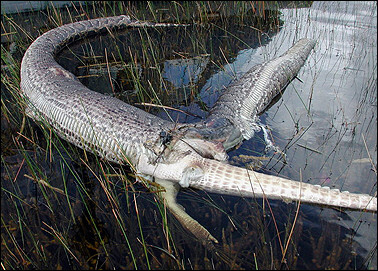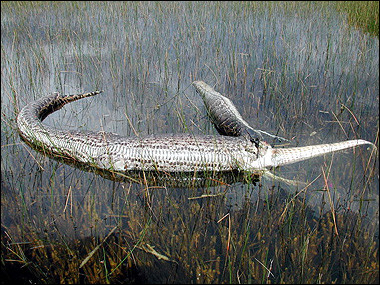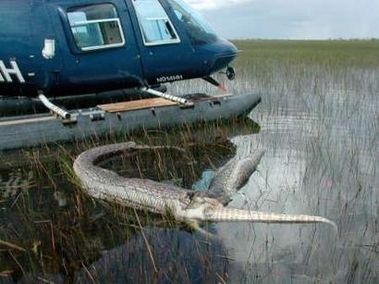Fatal mistake: giant snakes eats alligator
The National Park Service released photos that show the carcass of an American alligator that was almost swallowed by a Burmese python.
Park officials discovered the animal carcasses in a remote part of Everglades National Park, in south Miami-Dade, Florida, on Monday, Sept. 26, 2005. It appears that the 13-foot long Burmese python attempted to swallow the six-foot alligator before its stomach ruptured, resulting in the deaths of both animals.
American alligators are native to the Everglades, while the Burmese python is not. Like many other alien species in Florida, the Burmese python today has an established populations in Florida’s wildlands, where is eats native species and causes ecological damage.
 Michael Barron of the National Park Service took this picture of a carcass of an alligator as it protrudes out from the body of a dead Burmese python in Everglades National Park, Florida.
Michael Barron of the National Park Service took this picture of a carcass of an alligator as it protrudes out from the body of a dead Burmese python in Everglades National Park, Florida.
The origin of Burmese pythons in Florida habitats is the international pet trade — more than 144,000 Burmese pythons have been imported to the U.S. in the past five years. The snake, usually sold for less than $20 when young, grow quickly and can attain a length of 20 feet. Many pet owners release their snakes go in the wild well before they reach this size.
The economic cost of invasive species in the U.S. is estimated at $137 billion a year, according to a study by Cornell University in 1999. The study also found that approximately 50,000 non-native (non-indigenous) species have been introduced into the United States and that 42% of the species on the Threatened or Endangered species lists are at risk primarily because of non-indigenous species.

Michael Barron of the National Park Service took this photograph that shows the carcass of an alligator as it protrudes out to the right from the curved body of a dead Burmese python in Everglades National Park, Florida. Image courtesy of NPS. The snake’s head is pointing towards the top of the image, while the alligator’s tail faces to the right.

Handout photo released on October 6, 2005 by Everglades National Park shows a dead Burmese python which had apparently swallowed an American alligator. Wildlife biologists found the Burmese python with the hind quarters of a dead American alligator protruding from the snakes mid-section on September 27, 2005. The stomach of the python still surrounded the head, shoulders, and forelimbs of the alligator. The alligator measured 98 cm snout-vent length (SVL), with a total length (TL) of 194 cm, or about 6 feet 4 inches. Everglades National Park/Handout
Related articles
Beyond bizarre: strange hairy antelope photographed in Kenya
(08/19/2010) Is it a hairy goat roaming the plains? An antelope with some genetic mix-up? At this point no one knows. This strange creature was photographed in Kenya’s Masai Mara National Reserve. Apart of the Serengeti plains, the Masai Mara covers 1,500 square kilometers and is home to a wide-range of iconic African savannah species, from elephants to lions and giraffes to hippos.The photos were first published on conservation organization WildlifeDirect’s website.
Photos: Gelatinous Blobfish in danger
(01/26/2010) A species dubbed “the world’s most miserable-looking fish” is at risk of extinction due to poor fishing practices, reports The Daily Telegraph.
Photo: Mystery ‘alien-beast’ in Panama is likely a sloth
(09/19/2009) The ‘mystery alien-beast’ discovered by four teens in a community in Panama and widely reported in the media over the past few days is likely a deformed sloth.
Chupacabra story is a hoax; likely a Xolo dog breed (Nov 1, 2007) An alleged chupacabra carcass found in Texas is likely a hoax to sell T-shirts say dog experts. The animal, described in an Associated Press report last week as “a cross between two or three different things”, was found as road kill last month near the Texas town of Cuero. The woman who discovered the carcass has been using it to market chupacabra T-shirts. In lively Internet discussions dog breeders say the carcass appears to be that of a Xoloitzcuintle or Xolo, otherwise known as a Mexican Hairless dog, rather than the blood-sucking creature of legend.
World’s only blue lizard heads toward extinction
(03/07/2007) High above the forest floor on the remote Colombian island of Gorgona lives a lizard with brilliant blue skin, rivaling the color of the sky. Anolis gorgonae, or the blue anole, is a species so elusive and rare, that scientists have been unable to give even an estimate of its population. Due to the lizard&spod;s isolated habitat and reclusive habits, researchers know little about the blue anole, but are captivated by its stunning coloration.
In search of Bigfoot, scientists may uncover unknown biodiversity in Malaysia
(02/01/2006) Malaysian scientists are scouring the rainforests of Johor state in search of the legendary ape-man Bigfoot, supposedly sighted late last year. But they are more likely to encounter some less fantastic but unique creatures that dwell in these still unexplored ecosystems.
Sex vs. Intelligence: Bigger balls mean smaller brain
(12/13/2005) In a recent study of bats, Scott Pitnick, professor of biology at Syracuse University, found that testis size is negatively correlated with brain size. In other words, the bigger the balls of a bat species, the smaller its brain.
Crocodile blood shows anti-HIV activity August 16, 2005
Scientists in Australia’s tropical north are collecting blood from crocodiles in the hope of developing a powerful antibiotic for humans, after tests showed that the reptile’s immune system kills the HIV virus. The crocodile’s immune system is much more powerful than that of humans, preventing life-threatening infections after savage territorial fights which often leave the animals with gaping wounds and missing limbs.
Frogs may help in fight against HIV October 1, 2005
A new weapon in the battle against HIV may come from an unusual source — a small tropical frog. Investigators at Vanderbilt University Medical Center reported this month in the Journal of Virology that compounds secreted by frog skin are potent blockers of HIV infection.
Two-headed turtle found in Havana, Cuba October 1, 2005
A baby two-headed turtle was found in Havana, Cuba on a river bank in the city forest. According to scientists of the local aquarium who inspected the animal, the turtle appears to be in good health.









